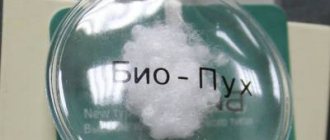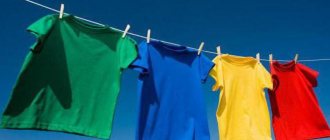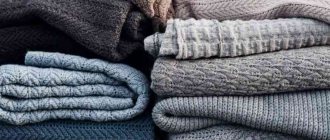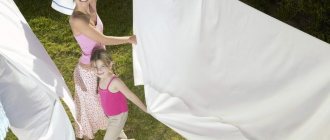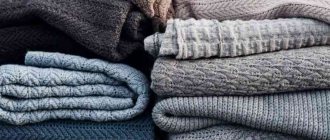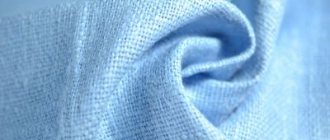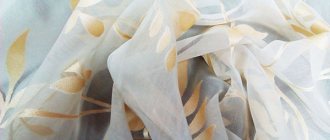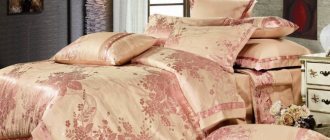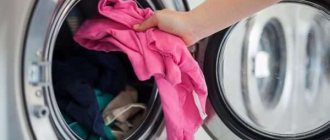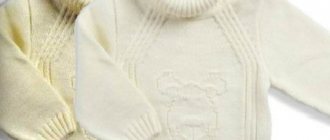The skin of infants is very vulnerable to external factors and therefore requires more careful care. An incorrectly chosen detergent for washing children's clothes often causes the development of redness, peeling, and rashes accompanied by itching. Moreover, the powders contain aggressive volatile particles that easily enter the respiratory tract. Therefore, in order to avoid harmful effects from them, you should carefully choose them and follow several important rules. Let's look further at how to wash a small child's clothes.
Features of washing clothes
You can wash babies' clothes by hand or in a machine. Manual processing allows you to cope with the task optimally, but requires a lot of time and effort. Washing by hand can be done not only with modern detergents, but also with regular baby soap.
This method has many advantages:
- minimum chemistry;
- no odor;
- maintaining the softness of the material;
- inclusion of natural ingredients;
- hypoallergenic;
- availability;
- delicate attitude towards fabric.
You can treat a newborn's things using soap shavings, and wash away dirt with bar soap. But this option is not suitable for a washing machine, and requires the use of children's laundry detergents suitable for automatic washing.
If you choose which wash is the most hygienic, then machine washing is inferior in this matter to manual processing. For hand washing a newborn's clothes, it is recommended to allocate a separate basin.
After washing, you must rinse the household chemicals out of the item very thoroughly. Gels are the easiest to rinse, powders are worse, soap is even worse.
You can find general rules for washing children's clothes here.
Overview of laundry products
Popular means for processing children's things are:
- Meine Liebe. Allows you to remove stubborn stains, is economical to use, does not contain phosphates, and is easily washed out of fabric fibers. The use of this powder is approved by dermatologists.
- Eared nanny. An effective product, hypoallergenic, odorless, and easy to rinse. The disadvantage is the presence of phosphates in the composition.
- Frosh. Does not contain dyes, phosphates, effectively removes severe stains. The product is hypoallergenic and washes out well. The disadvantage is the high cost.
- Stork. Does not emit strong odors, does not contain phosphates, contains aloe extract, and effectively removes stains. The downside is that you can’t wash silk and wool.
- Tide. It contains no phosphates, contains chamomile extract, and removes stains well. Disadvantage: pungent odor. In addition, the product may cause allergies.
As for soap and other hand washing products, there are several options:
- "Umka." Hypoallergenic, odorless product at an affordable price.
- "My baby". The disadvantages are a strong odor, poor foaming, and the inability to remove heavy dirt.
- "Eared nanny." A completely safe product that effectively removes even stubborn stains. Has a whitening effect and a pleasant smell.
- Duru. Economical to use, affordable price, beautiful design, hypoallergenic, low odor. Capable of whitening things, forms a large amount of foam.
- "Friend". A very effective product, inexpensive, with a pleasant smell. Completely hypoallergenic, foams well. It is used uneconomically and is rarely found on sale.
Washing powder popular with moms
The better: top 3 household products
A wide range of washing gels and powders allows you to find among all the variety ones aimed directly at children's underwear. They must have an appropriate indication on the packaging about this.
One of the main requirements is that the selected powder must be phosphate-free.
Video review of baby laundry detergents:
"Eared Nanny"
TM Ushasty Nyan presents a large list of products suitable for washing clothes for children and newborns. The cost of packaging 4.5 kg of powder reaches 1,000 rubles. Gel 1.2 l. – costs about 500 rubles, bar soap – from 35 rubles for 1 piece.
Domal "Baby"
Gel TM Domal is produced in Germany. It is intended for washing clothes of newborns from birth, it is hypoallergenic. The product has passed all necessary inspections and tests confirming the safety of the product. A 750 ml package costs about 500 rubles .
"The world of childhood"
This is natural soap powder produced in the Russian Federation.
It is designed for washing clothes of a newborn baby. This is a hypoallergenic product with disinfectant and antibacterial properties. The powder form is based on natural soap shavings . A gel is also available, the cost of the bottle is 0.75 liters. - about 200 rubles.
Modern powder for newborns
Of course, it’s good to plan to wash children’s clothes only with soap when mom has a whole platoon of helpers at her side. But, more often than not, the mother alone performs all household functions. She physically does not have time to wash the baby’s underwear and diapers by hand, so she even has to wash new things in the machine. And technology is very capricious when it comes to soap and soap shavings, so you have to look for compromises.
Washing powder care can be an alternative to baby soap. You just need to choose the right one. Make sure that on the packaging there is not just an o, but the inscription “suitable from the first days of life.” It's better and more reliable.
Your goal is phosphate-free powders. Here is a list of the most famous laundry detergents:
- Dally Med is a hypoallergenic phosphate-free powder for newborns, created according to the original German recipe. Good: natural composition, wide variety of products. Bad: there are optical brighteners, there are fragrances.
- Stork - there is a gel with herbal extracts and silver ions for newborns, as well as natural soap for washing. Good: no fragrance, hypoallergenic. Bad: Optical brightener. Diapers washed with this powder will not allow the skin to breathe.
- Soap powder for newborns is a natural powder, suitable for hand and machine washing and soaking. Antibacterial and disinfectant properties, does not cause allergies.
- Eared Nannies - a large assortment of products for washing children's clothes and clothes for newborns. The quality is confirmed by the Research Institute named after. R.R. Harmful.
- Toddler for newborns - does not contain harmful additives, and is ideally washed out with water when rinsing.
- “Our Mother” detergent for washing clothes for newborns is effective on any stains and copes without boiling. Created on the basis of water enriched with silver ions with extracts of medicinal plants.
- Domal baby laundry gel. German natural product for machine and hand washing with natural chamomile extract and without harmful impurities. Additional dermatological testing has been done so the newborn's diapers and things will be fine.
In an automatic washing machine: on what mode, at what temperature?
Automatic washing should be carried out on the “Baby Clothes” or “Children’s Clothes” mode. In this case, the temperature is set to the maximum, up to +90ºС, and the rinsing is more thorough than with other modes.
If there is no special mode for children's clothes on the washing machine, you need to focus on the type of material and set the temperature to high. For diapers it is 80-90ºС.
It is also necessary to set up an additional rinse. If the fabric is thin and light, the temperature can be set lower, but not less than +40ºС.
Work order:
- If there are difficult stains on your clothes, it is better to wash them in advance.
Fasten, if any, buttons on clothes.- Place items in the washing machine drum. It is advisable that the load is not full - this will allow you to better wash all the products.
- Pour powder or gel into the detergent container.
- Select a mode designed for washing children's clothes. If it is not there, make settings according to the type of fabric.
- Adjust the water heating temperature.
- Set additional rinse.
- Start the washing process.
After the end of the washing cycle, items are hung out to dry without leaving them in the washing machine for a long time.
Do we wash by machine or by hand?
Another question that causes quite heated discussions is how best to wash children's clothes - manually or in an automatic machine. Let's consider each option separately.
Of course, hand washing has the advantage of being more hygienic. A separate basin is used for hand washing children's underwear, which means that the newborn's things do not come into contact with adult clothing.
But that’s probably where the advantages end. They are being replaced by a number of disadvantages that should be taken into account when choosing a washing option.
- When washing by hand, it is impossible to rinse things as well as when washing by machine. This means that in order to remove cleaning products from the fabric, you will have to rinse more times.
- Spin. Competing with a washing machine in this matter is also not easy. If things are washed in the summer, minutes may seem insignificant, because in the sun everything dries in a matter of hours. But what about in the cold season, when the sun does not pamper us with its presence and the laundry dries in the room for a day, or even two?
- Hand washing is possible only at a temperature of 30-40 degrees, no more. Otherwise, you risk damaging the skin of your hands (even when using gloves). For half of the stains, water at this temperature will be useless and it will not be possible to remove the stains. This means you will need boiling.
Needless to say, pediatricians prefer hand washing using baby soap. Of course, it’s always much easier said than done. But what about a young mother who doesn’t have an extra hour, not only for laundry, but even for sleep?
The answer is obvious: use the washing machine, following our recommendations.
Manually
Hand washing should be done at a sufficiently high temperature. You can use hot water at a tolerable temperature or wear two gloves on both hands - cotton and rubber.
Procedure:
- Washing powder or grated baby soap is diluted in prepared water.
- Dip children's clothes into soapy water.
- If there are stained areas on things, they should be treated separately (soap and rub).
- For better washing, it is advisable to soak things for at least 15 minutes.
- Rub your hands after soaking, paying attention to areas with stains.
- Drain the soapy water.
- Rinse things, changing the water at least 3 times.
You should rinse things not in hot, but in warm water. The last rinse is cold.
The spots are coming. And they retreat
When the first complementary foods appear, new worries are added. And if store-bought jars of homogenized puree for babies eliminate the problem of preparing special foods, the mother will have to deal with the stains alone. And there will be spots every day. How to get rid of it?
The main commandment is no chlorine! Any chlorine-based bleach causes allergies in a delicate newborn baby, and this special aroma of bleach is practically indestructible. Also prohibited are any products containing soda and fluorescent substances. They are designed to remain on the surface of the fabric, giving the appearance of whiteness.
The best remedy is hydrogen peroxide. It has a number of advantages:
- safe for the skin of newborns;
- easy to rinse out of fabric;
- removes almost any stain, no matter what its origin, especially if it is not old;
- simultaneously disinfects the fabric from microbes.
At high temperatures, almost all stains also come off. But it is not necessary to boil the laundry, especially since this will turn it grey. A temperature of 60 degrees is already enough.
No matter what ratings you are guided by, the baby will definitely make his own adjustments. Only his sensitive skin is able to choose the right approach to his clothes. Therefore, proceed from the safest means, and from them choose the most suitable one.
In front of the maternity hospital
When preparing things for the baby before the maternity hospital, you should inspect and wash them. This is necessary both for new things and for those passed down from older children. You can wash the first items by hand or use a machine for this.
To do this, you must comply with all requirements for the care of children's clothing, including:
- washing using products approved for newborns;
- thorough rinsing;
- ironing on both sides;
- storage after processing in a closed cellophane bag.
It is important to choose things made from natural materials, even if they are inferior in beauty to their synthetic counterparts. For the health of the newborn, all products must be made from hypoallergenic materials.
Washing new clothes
Not everyone knows that even brand new baby clothes need to be washed. Thanks to this, it is possible to get rid of paint residues and possible bacteria remaining on the clothes. Children's clothes are often treated with starch to give them a marketable appearance; it should also be washed out of new items in children's wardrobes. The same goes for diapers. Timely washing guarantees the health of children.
Items such as fur envelopes and other warm clothing are especially difficult to disinfect. In this case, you should use a steam generator or even a simple iron in steam mode instead of washing. Steam treatment must be done both inside and outside the item.
Do new clothes need treatment before wearing them for the first time?
New clothes for a newborn must be washed. Labels, tags and stickers are first removed from them.
Before getting into the hands of a young mother, diapers and baby vests go a long way:
- they manage to be in the hands of those who make fabric and sew clothes, sellers, warehouse workers, and other buyers;
- products may retain traces of dyes;
- many fabrics are treated against caking and mold with chemicals, starch, etc.
To protect the baby, things must be washed and ironed according to all rules. Just as with standard washing of newborn clothes, it is necessary to set an additional rinse.
How to wash newborns' clothes before the maternity hospital
Many mothers are interested in the question of how and when to wash things for a newborn before the maternity hospital.
Baby vests, rompers, and diapers are subject to processing. New clothes are starched to maintain their shape; putting them on the baby’s delicate skin is prohibited. The fabric went through cutting, sewing, packaging, repurchase, and many other stages before it came into our hands.
A washing machine will help remove germs. Don't forget to include an extra rinse, use safe detergents!
After drying, iron with steam from the wrong side, right side. The high temperature will completely kill dangerous germs and bacteria and make the fabric soft and tender.
When going to the maternity hospital, put diapers, outerwear, and underwear separately. They have different purposes; in the first year they should be stored and washed separately.
How often?
Baby's clothes need careful and frequent washing . It is necessary to replace things as they become dirty, even if it is, for example, a small stain after regurgitation.
Another rule in caring for newborns is changing clothes after bathing. This must be done even when the previous set appears clean.
No matter how many things a young mother has in her arsenal, children’s dirty laundry should not be accumulated, as it becomes a breeding ground for the development of bacteria.
It is advisable to do laundry daily . Bed linen should be replaced every 2 days or more often if it becomes dirty of any kind. Clothes - at least once a day.
Diapers
Diapers are the baby's first clothing. Proper organization of their washing will maintain hygiene and save mom’s time.
When choosing how best to cope with a task, using a machine or with your hands, you need to consider the following points:
- Automatic washing saves time;
- things come out of the machine almost dry, since the spin cycle is much better than when washing by hand;
- manual processing allows you to use any detergent for washing children's things, and only special preparations can be used in the machine.
The frequency of washing diapers, as well as their quantity, depend on whether disposable diapers are used when caring for the baby. If they are used almost constantly, then the frequency of washing diapers is reduced significantly.
In an automatic machine, it is advisable to carry out high-quality washing at a temperature of at least +60ºС on the main “Children's clothing” mode. As an option, wash using the “manual” mode or taking into account the type of material.
Procedure for hand washing diapers:
Rinse the diapers under running water to remove any major dirt and rinse out any urine.- Prepare a solution based on hot water and soap shavings or powder.
- Soak things.
- Leave them for a quarter of an hour.
- Rub and mash.
- Rinse with multiple water changes.
Since diapers are wearable clothing, it is necessary for a newborn to iron them. The most important thing is to treat the inside, which is in direct contact with the baby’s skin.
What powder to use
When washing in an automatic machine, do not use soap or soap shavings. Only washing powder needs to be added. This must be a specialized product that says “For children's things” or a similar inscription. But it’s best to play it safe and look for the inscription “From the first days of life”, this will definitely be the best option.
Important! If the mother does not know which detergent to choose, it is worth purchasing several baby powders in small packages. It is necessary to choose products that do not contain phosphate compounds, chlorine, surfactants, or optical brighteners.
Removing difficult stains
Stains on babies' clothes can be washed only with products that are harmless to the newborn. Products containing chlorine and substances that create a visual effect of whiteness are prohibited .
Such products can remain on the surface of fabrics and create problems, impeding the breathability of materials and causing allergies.
Hydrogen peroxide has proven itself as a stain remover from children's clothing due to the following qualities:
- disinfection of matter from microbes;
- removal of a large list of contaminants;
- good rinsing from the material;
- safe for children's skin.
Contamination of newborn clothes is predominantly biological in origin. Therefore, it is quite possible to wash them without complex stain removers, which are also not safe for the baby.
If you don't let the stains dry, it will be much easier to deal with them even with simple soap.
Feces
Washing diapers and onesies from feces must be done after the items have been washed under cold water.
After this, you can prepare a solution for soaking:
- For 3 l. hot water you need 2 tbsp. l. soda
- The solution is stirred.
- Soak clothes for 1-1.5 hours.
- Rinse.
- Wash in the usual way.
Additionally, it is possible to sprinkle the stained area with baking soda and moisten it with vinegar. The chemical reaction of these components will allow for better removal of stains.
Another way is to soap the stain with baby soap and then soak it in hot water for a couple of hours. Finish by machine washing at high temperature.
Urine
Urine stains on diapers can be removed using baking soda, ammonia or vinegar.
Procedure:
- The spots are treated with one of the preparations. If you choose soda, you must first moisten the dry cloth.
- Set aside for 15-30 minutes.
- Wash as usual.
Fresh lemon juice can also serve as a natural bleach. Products treated with it, as in other cases, need to be washed and thoroughly rinsed.
Spit marks
Fresh marks from regurgitation can be washed away well with baby soap. If the stains have become old, they can be treated with a soda solution.
Milk
Milk stains can be difficult to remove without first soaking . It is advisable not to let them dry out and be absorbed deep into the fibers.
The stain remover from the “Eared Nanny” series will help you deal with stains from breast milk or baby formula. Thorough soaping with Stork soap will also help.
Baby cream
Greasy stains from the cream that was used to lubricate the folds for diaper rash can also leave marks on the baby’s underwear. They can be removed with baking soda or baby powder.
Procedure:
- place a clean towel under the stained area;
- Sprinkle the stain with baby powder or baking soda;
- place a sheet of white writing paper on top;
- turned inside out;
- iron the area with the stain - the heat will stimulate the absorption of fat into the bulk product.
With old greasy marks, this method may not be effective.
What to do if stains won't come off?
The main method of combating such severe pollution is speed. If you manage to remove the stain without delay, the results will most likely be excellent.
In other cases, you will have to try using different means, including folk ones:
- Milk stains should be washed in cool water with soap and a few drops of ammonia;
- Wipe the fruit juice stain with a cotton swab dipped in a mixture of ammonia and water, and wash after a while;
- Fruit stain - mix vodka with glycerin (1:1) and wipe the stain;
- A fresh grease stain can be removed using warm bread crumbs or soap solution;
- Blood stains can be removed with cold water and baby soap;
- A tea stain can be removed by wiping it with a cotton swab dipped in a mixture of ammonia (half a teaspoon) and glycerin (2 teaspoons).
Proper drying
After washing, the baby’s clothes are wrung out and placed in one pile. The best place to dry children's things is outdoors . This is especially important when items are not wrung out well enough after hand washing. After the machine, the products are removed from the drum almost dry.
Be sure to dry the newborn's bedding and belongings indoors in a dry place, creating all the conditions for quick drying.
If drying is carried out in a damp place, then the clothes will not only remain damp for a long time, but can also become a breeding ground for mold and other pathogens.
Adviсe:
If your washing machine has a drying function, you can use it.- Drying clothes outside is preferable to drying them in an apartment. But for polluted areas of the city, it would be better to organize drying in an apartment.
- Heaters and other heating devices will help dry things faster by providing heat sources.
In this case, it is necessary to adhere to fire and electrical safety rules, placing children's clothing not on the devices themselves.
Only completely dry items can be sent for storage.
How to store children's clothes?
A significant role is played not only by washing and ironing children's clothes, but also by their proper storage. After all, furniture and household items contain harmful bacteria and microorganisms. Therefore, for storage it is worth selecting a separate closet or chest of drawers, which should be washed from time to time.
Storage of children's clothing usually does not last long, because children's wardrobe items are often used and outgrown quickly. That's why it's worth placing them so that it's easy to get out. Place those items that need to be taken out especially often closest, and then those that need to be used less often. Store outerwear separately from other things.
How to iron?
It is necessary to iron the clothes of a newborn in the first month of life on both sides. Use a hot iron for this.
Steam treatment during ironing serves for additional disinfection . After processing, all ironed clothing is placed in a plastic bag or fabric cover.
Only in the first month of a newborn’s life, all of his underwear must be ironed on both sides. Then you can move on to simpler processing - from the inside of things.
